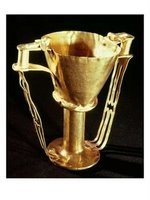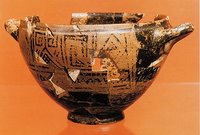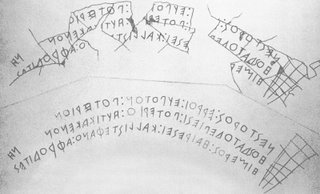Nestor's Cup
For many people this will conjure up the famous description of King Nestor's cup in the Iliad (11.632-637):

For Heinrich Schliemann it would bring to mind the golden cup that he unearthed at Mycenae in 1876 from Shaft Grave IV of Grave Circle A.
 Others might think of the clay drinking cup found in 1954 at Pithikoussai, which dates from the 8th century, and seems to identify itself as Nestor's cup in a three line inscription that is one of our oldest examples of the Greek alphabet (written from right to left):
Others might think of the clay drinking cup found in 1954 at Pithikoussai, which dates from the 8th century, and seems to identify itself as Nestor's cup in a three line inscription that is one of our oldest examples of the Greek alphabet (written from right to left):

πὰρ δὲ δέπας περικαλλές, ὃ οἴκοθεν ἦγ᾽ ὁ γεραιός,
χρυσείοις ἥλοισι πεπαρμένον: οὔατα δ᾽ αὐτοῦ
τέσσαρ᾽ ἔσαν, δοιαὶ δὲ πελειάδες ἀμφὶς ἕκαστον
χρύσειαι νεμέθοντο, δύω δ᾽ ὑπὸ πυθμένες ἦσαν.
ἄλλος μὲν μογέων ἀποκινήσασκε τραπέζης
πλεῖον ἐόν, Νέστωρ δ᾽ ὁ γέρων ἀμογητὶ ἄειρεν.[And beside them a beautiful cup, brought from the old man's home, studded with golden nails. There were four handles on it, and around each of them two golden doves were feeding. There were two bases under it. Another man would struggle to take it from the table when it was full, but old Nestor could lift it effortlessly.]

For Heinrich Schliemann it would bring to mind the golden cup that he unearthed at Mycenae in 1876 from Shaft Grave IV of Grave Circle A.
 Others might think of the clay drinking cup found in 1954 at Pithikoussai, which dates from the 8th century, and seems to identify itself as Nestor's cup in a three line inscription that is one of our oldest examples of the Greek alphabet (written from right to left):
Others might think of the clay drinking cup found in 1954 at Pithikoussai, which dates from the 8th century, and seems to identify itself as Nestor's cup in a three line inscription that is one of our oldest examples of the Greek alphabet (written from right to left):
ΝΕΣΤΟΡΟΣ : Ε[ΙΜ]Ι : ΕΥΠΟΤ[ΟΝ] : ΠΟΤΕΡΙΟΝ
ΗΟΣ Δ Α{Ν} ΤΟΔΕ ΠΙΕΣΙ : ΠΟΤΕΡΙ[Ο] : ΑΥΤΙΚΑ ΚΕΝΟΝ